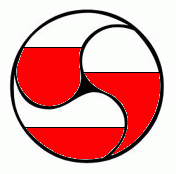
The Shifting-Mass Overbalanced Wheel
Why it isn't perpetual motion.
From the 8th century to the present time inventors have sought to achieve perpetual motion by use of wheels with shifting weights. None have worked, but that doesn't stop people from using the same idea again and again, altering mechanical details, often with incredibly complex designs. I call this "reinventing the square wheel".
 |
 |
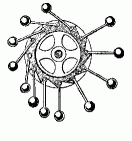 |
| Bhaskara's first perpetual motion wheel. Mercury in curved spokes. |
Bhaskara wheel with mercury in tilted vials. |
Overbalanced wheel with weights on articulated arms. 18th century. |
|---|
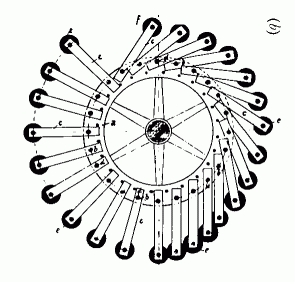 |
 |
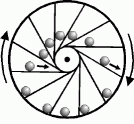 |
| Early articulated-mallet wheel. | Articulated arm wheel. Often called the "Arabian Wheel". |
Rolling-ball wheel. 17th century. |
|---|
| Note on the pictures. The early wheels are redrawn from an Arabian manuscript dated between the 9th and 12th centuries CE. All except the rolling ball wheel probably originated in 8th century India. We have rotated some of them to correctly relate to gravity. The earliest known manuscripts had already passed through the hands of a number of copyists, and are difficult to interpret, especially for historians not skilled in mechanics. Note particularly the "Arabian Wheel". When correctly oriented, as shown here, this shows remarkable attention to the correct detail of how the hinged arms curve when hanging under the force due to gravity. The original must have been conceived by someone who understood this very well, or who actually had built such a mechanism. |
Quite a number of books tell of this futile quest, citing examples with nice pictures of the failed designs. Few of these books give a simple conceptual explanation of why they don't work and why they can't work. Nor do these books expose the flaws of thinking that led people to believe they might work.
The physicist is tempted to cite conservation laws of energy, momentum, and angular momentum, or do a force and torque analysis, perhaps even mentioning centripetal force. These concepts are not well understood or even accepted by the non-scientist reader.
Can these wheels be analyzed using simple, conceptual physics, and simple concepts such as force, mass, velocity, acceleration and work, with appeal to examples from everyday experience that most people understand and accept? I shall try, and I'll also try to keep this discussion at the level of a freshman college physics course.
Overbalanced wheels are of little interest to the physicist, for physicists understand, from many well-established laws and many lines of argument, that even if there were such a thing as perpetual motion, this is certainly not the way to achieve it.
All of these wheels use geometric design or mechanical devices to shift mass to a larger radius from the wheel's axle. We can only speculate what the inventors assumed to be the operating principle. Here are three possible reasons for motion, expressed in modern terminology:
- More mass is kept continually on one side of the axle, presumably unbalancing the wheel to sustain rotation in one direction.
- The masses on one side of the axle continuously have greater torque, supposedly unbalancing the wheel to cause rotation on one direction.
- As each weight shifts to larger radius, an impulse is given to the wheel, sustaining rotation.
In any of these cases, the motive principle might be supposed to (a) cause the wheel to accelerate, or (b) simply deliver greater power output at constant speed. The second possibility is seldom mentioned in the perpetual motion literature. But some inventors showed a brake in their designs, to prevent the machine's speed to increase to dangerous values. If the machine were driving a grinding wheel or lift pump, presumably the load on the output would be considered sufficient to maintain constant speed of the machine.
But all of these wonderful speculative fantasies mean nothing if the wheel simply refuses to turn, and that's exactly what happens with any of these wheel designs. Such failure could always be rationalized by saying "The friction prevents the motion. Reduce the friction and it will surely work." But friction isn't the problem. Reduce the friction and the machines still refuse to turn even when all friction and other energy-dissipative processes are totally eliminated.
The inventors overlook some important basic physics. The earlier inventors can be excused, since those physics principles were not yet well understood. Inventors today who recycle modifications of the same designs have no excuse.
Imagine a wheel with regularly spaced spokes and masses on spokes. The masses are located at the middle of each spoke. Let the wheel's rotation axis be vertical, so the wheel is rotating in a horizontal plane. Suppose one of the masses is suddenly released so it moves out to the end of its spoke, where it is stopped by some restraint or catch. How will this change the rotation speed of the wheel?
To illustrate what really happens, consider an experiment that anyone can perform. Attach a weight on the end of a rope and swing the weight around a horizontal circle. Anyone who has done this knows that if the rope is released to allow the weight to suddenly move to a larger radius, the stone's angular speed (revolutions/time) decreases. Also, the weight's speed decreases, though that fact is not readily apparent to the eye. Its kinetic energy of motion is now smaller. That's not encouraging. This happens because the rope does negative work on the stone during the change of radius. If the rope is "let out" gradually, or if the rope only exerts force to stop the stone at the new radius, the force the rope exerts on the stone is opposite to the stone's displacement. Therefore the rope does negative work on the stone. This is equivalent to saying that the stone does positive work on the rope, and ultimately work is done on whatever the rope is attached to at the center of rotation. [For physicists reading this, we note that conservation of angular momentum applies, and the rope tension provides nearly zero torque, so the product of moment of inertia and angular velocity remains nearly constant.]
Perpetual motion wheels are invariably cyclic, that is, all motions of the wheel and its parts are repeated exactly during each complete revolution. So if a weight moves to a larger radius once per cycle, it must also be pulled back to the original radius later during the cycle. The work done in changing the radius by a certain amount from large to small is equal and opposite to the work done in changing the radius by the same amount from small to large. We gain no net energy per cycle.
Now imagine such a rotation in a vertical plane, so that gravity can play a role. Since the wheel's motion is cyclic, and the motion of the mass is cyclic, the work done on the mass by gravity as the mass moves down is of equal size to the work it does against gravity moving back up. There's no gain in net energy per cycle.
One of the most fundamental and well-tested facts of physics is that forces combine by vector addition. [This is sometimes called the "superposition principle" of force.] When two forces act on a body simultaneously, the net effect on the body is simply the vector sum of the forces. From this follows the result that when two forces do work on a body, the net work done on that body is the same as the work done by the vector sum of those forces.
We have seen that the radially shifting mass alone does no net work on the wheel during each cycle. We have also seen that gravitational force does no net work on the wheel or the mass during each cycle. So the two processes acting together will do no net work on the wheel during each cycle.
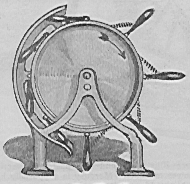 |
This is an outline of the reasons why physicists understand that all overbalanced wheels, no matter how ingeniously constructed, can never provide more energy than they were given initially. In fact, the situation is even worse, for the more ingenious and complex is the mechanism for maintaining the overbalance, the more poorly the wheel will perform due to mechanical inefficiency.
But the idea never dies.
Still, people continue their quest for overbalanced wheel perpetual motion, and might as well be re-iventing square wheels. This example is from The Perpetual Motion Myth in the March 1925 issue of Science and Invention magazine, pp. 1078-1010. It also appeared in an article titled Das Perpetuum in Wissen und Fortschritt, 1929, vol. 3., part 2, pp. 145-148. It is hardly different from Honnecort's version, except for the addition of springs and a restraining shield to control the swinging weights. This isn't an improvement, for the weights dragging on the shield slow the wheel by friction.Why not use the restraining shield to actually continually push the weights into an overbalanced condition? This inventor thought that might work, and even got the idea patented.

It seems simple enough. Weights (66, 67, 68, 69) are at the ends of freely sliding rods. Assume the weights are free to rotate on frictionless bearings. The curved shield (54) at the left pushes the rods to shift the weights to the right, thereby ensuring that there's always more clockwise torque on the right, causing clockwise motion. But wait. The curved shield must necessarily exert a force that isn't axial, but perpendicular to the shield. I have added this to the diagram. This force R (in black) acts downward and to the right. It has a horizontal component, H, that does what the inventor wants. But the inventor neglects the downward component V, acting downward that provides a counter-clockwise torque. And, upon calculation, the geometry of the curved shield ensures that the total clockwise torques are equal to the total counter-clockwise ones, and there's no net torque to initiate or sustain motion.
I like neat and simple perpetual machines with everything clearly exposed, including the flaws which can be easily seen by all but those who would rather believe in the impossible.
This example is worth careful study, for it is an example of the fallacy of all attempts to maintain overbalance of a wheel by mechanical means. The mechanism that produces the overbalance necessarily requires the wheel to exert a force on the shifting weight, and because of Newton's third law, this causes a force, and a torque, that exactly counterbalances the effect of the overbalance.
 Since our theme is puzzles, consider the pretty design shown here.
The idea for this as a perpetual motion puzzle was sent to me by Slawek Liszewski.
It is a wheel with three equal compartments, constructed using arcs of circles.
Put equal amounts of liquid (red) half-filling each compartment.
(1) In what position(s) will the wheel be in static equilibrium?
Or will the wheel be in static equilibrium in every position?
(2) Will these answers be the same for any chosen amount of liquid
(but with the same amount in each compartment)?
Show and justify all mathematical steps in your solution.
Since our theme is puzzles, consider the pretty design shown here.
The idea for this as a perpetual motion puzzle was sent to me by Slawek Liszewski.
It is a wheel with three equal compartments, constructed using arcs of circles.
Put equal amounts of liquid (red) half-filling each compartment.
(1) In what position(s) will the wheel be in static equilibrium?
Or will the wheel be in static equilibrium in every position?
(2) Will these answers be the same for any chosen amount of liquid
(but with the same amount in each compartment)?
Show and justify all mathematical steps in your solution.
This puzzle illustrates a general question that is at the heart of all shifting-weight overbalanced wheels. I do not know whether it yields to a simple conceptual/physical/mathematical argument. It might require calculus. Remember that we are not asking for a complete analysis. We only ask whether there are positions of stable equilibrium, and where they are.
Latest revision, July 2010.
|
|
Re: Answers left as exercise for the student. Send your answers to Donald Simanek at the address shown to the right. The earliest good one(s) that arrive may be posted here, with credit to author. I will post (at my discretion) answers that are in simple to explain, clear, correct, perceptive, and which stimulate thinking and further discussion. Posted answers, whether written by me or by others, do not always represent the final word on a given proposal. On several occasions perceptive readers have noticed things we missed, or suggested simpler ways to explain something. So don't hesitate to skeptically rethink given "answers".
Return to The Museum of Unworkable Devices.
Return to Donald Simanek's front page.